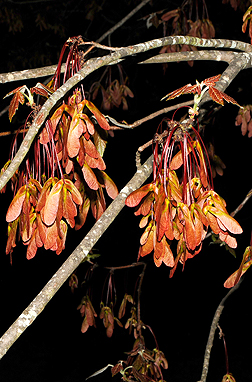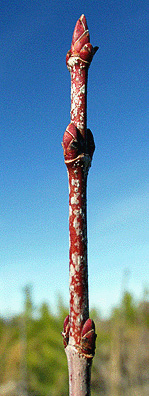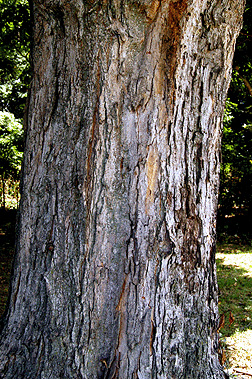VT Dendro Lab Notes
red maple
Aceraceae
Acer rubrum
Leaf: Opposite, simple, 3 to 5 palmate lobes with serrated margin, sinuses relatively shallow (but highly variable), 2 to 4 inches long; green above, whitened and sometimes glaucous or hairy beneath.
Flower: Attractive but small, occur in hanging clusters, usually bright red but occasionally yellow, appear in early spring, usually before leaves.
Fruit: Clusters of 1/2 to 3/4 inch long samaras with slighly divergent wings, on long slender stems. Light brown and often reddish, ripen in late spring and early summer.
Twig: Reddish and lustrous with small lenticels, buds usually blunt, green or reddish (fall and winter) with several loose scales usually present, leaf scars V-shaped, 3 bundle scars, lateral buds slightly stalked, may be collateral buds present.
Bark: On young trees, smooth and light gray, with age becomes darker and breaks up into long, fine scaly plates.
Form: Medium sized tree up to 90 feet. In forest, trunk usually clear for some distance, in the open the trunk is shorter and the crown rounded.







Notes:
VT Dendro Lab Notes
sugar maple
Aceraceae
Acer saccharum
Leaf: Opposite, simple and palmately veined, 3 to 6 inches long, 5 delicately rounded lobes, entire margin; green above, paler below.
Flower: Light yellow-green, small, clustered, hanging from a long, slender (1 to 3 inch) stem, appearing with or slightly before the leaves in early spring.
Fruit: Two-winged horseshoe-shaped samaras about 1 inch long, appearing in clusters, brown when mature in in the fall.
Twig: Brown, slender and shiny with lighter lenticels; terminal buds brown, very sharp pointed, with tight scales.
Bark: Variable, but generally brown, on older trees it becomes darker, develops furrows, with long, thick irregular curling outward, firm ridges.
Form: Medium to tall tree (to 100 feet) with very dense elliptical crown.







Notes:
VT Dendro Lab Notes
poison-ivy
Anacardiaceae
Toxicodendron radicans
Leaf: Alternate, trifoliate, 7 to 10 inches long, leaflets are ovate and irregularly toothed, shiny green above, paler below. TOXIC.
Flower: Species is dioecious; small, yellowish green, appearing in clusters, present late spring to early summer. TOXIC.
Fruit: Greenish white, round, 1/4 inch in diameter, borne in a hanging cluster, ripe in late summer and persist through winter. TOXIC.
Twig: Slender, gray- to red-brown, sparingly pubescent or glabrous, slender aerial roots present and older growth becomes densely covered and "hairy" in appearance; buds are stalked, naked, fuzzy brown, 1/4 inch long. TOXIC.
Bark: Dark gray, densely covered in aerial roots. TOXIC.
Form: May be present as a low (6 to 18 inches), spreading "carpet" on the forest floor, as a climbing vine, or as a bush.







Notes:
VT Dendro Lab Notes
flowering dogwood
Cornaceae
Cornus florida
Leaf: Opposite, simple, 3 to 5 inches long, oval in shape with an entire or slightly wavy margin, arcuately veined, green above and slightly paler below.
Flower: Species is monoecious; very small and inconspicuous tight cluster, but surrounded by 4 very showy, large, white (occasionally pink) bracts, 2 inches in diameter, appearing in mid-spring.
Fruit: A shiny, oval red drupe, 1/4 to 1/2 inch long, in clusters of 3 to 5, maturing in fall.
Twig: Slender, green or purple (purple on sunlit side), later turning gray, often with a glaucous bloom. The terminal flower buds are clove-shaped, vegetative buds resemble a dull cat claw.
Bark: Gray and smooth when young, turning very scaly to finely blocky.
Form: A small tree with a short trunk that branches low, producing a slightly rounded to flat-topped crown. Branches are opposite, and assume a "candelabra" appearance.







Notes:
VT Dendro Lab Notes
white oak
Fagaceae
Quercus alba
Leaf: Alternate, simple, oblong to ovate in shape, 4 to 7 inches long; 7 to 10 rounded, finger-like lobes, sinus depth varies from deep to shallow, apex is rounded and the base is wedge-shaped, green to blue-green above and whitish below.
Flower: Species is monoecious; male flowers are yellow-green, borne in naked, slender catkins, 2 to 4 inches long; female flowers are reddish green and appear as very small single spikes; appearing with the leaves in mid-spring.
Fruit: Ovoid to oblong acorn, cap is warty and bowl-shaped, covers 1/4 of the fruit; cap always detaches at maturity; matures in one growing season in the early fall.
Twig: Red-brown to somewhat gray, even a bit purple at times, hairless and often shiny; multiple terminal buds are red-brown, small, rounded (globose) and hairless.
Bark: Whitish or ashy gray, varying from scaly on smaller stems to irregularly platy or blocky on large stems. On older trees smooth patches are not uncommon.
Form: A very large tree; when open grown, white oaks have rugged, irregular crowns that are wide spreading, with a stocky bole. In the forest crowns are upright and oval with trees reaching up to 100 feet tall and several feet in diameter.







Notes:
VT Dendro Lab Notes
black oak
Fagaceae
Quercus velutina
Leaf: Alternate, simple, 4 to 10 inches long, obovate or ovate in shape with 5 (mostly) to 7 bristle-tipped lobes; leaf shape is variable, with sun leaves having deep sinuses and shade leaves having very shallow sinuses, lustrous shiny green above, paler with a scruffy pubescence and axillary tufts below.
Flower: Species is monecious; males borne on slender yellow-green catkins; females are reddish green and borne on short spikes in leaf axils, appearing in spring with the leaves.
Fruit: Ovoid acorns, 1/2 to 3/4 inch long, 1/3 to 1/2 enclosed in a bowl-shaped cap; cap scales are loosely appressed (particularly loose on edges of cap), light brown and fuzzy, matures in 2 years in late summer and fall.
Twig: Stout and red-brown to gray-green, usually glabrous but rapidly growing twigs may be hairy; buds are very large (1/4 to 1/2 inch long), buff-colored, fuzzy, pointed and distinctly angular.
Bark: At first gray and smooth, becoming thick and very rough, nearly black and deeply furrowed vertically with horizontal breaks. The inner bark is yellow-orange and very bitter tasting.
Form: A medium sized tree to 80 feet with an irregular crown and a tapering, somewhat limby bole.







Notes:
VT Dendro Lab Notes
yellow-poplar
Magnoliaceae
Liriodendron tulipifera
Leaf: Alternate, simple, palmately veined, orbicular, 4-lobed with an entire margin, 4 to 8 inches long, notched to flat top. Somewhat shaped like a tulip, light green to green.
Flower: Perfect, showy, resembling a large tulip, but high in the tree, 2 1/2 inches long, with yellow-green petals and an orange corolla, appearing in late spring to early summer.
Fruit: An oblong (cone-like) aggregate of samaras (2 inches long), deciduous at maturity; each samara is 1-winged, 1 1/2 inches long, and curved upwards at seed cavity (resembling the front keel of a boat); maturing August to October and disseminating through late fall and winter; base whorls of samaras persist on fruit into following spring and resemble wooden flowers high in the tree.
Twig: Red-brown in color, often with a shiny appearance or a waxy bloom. Stipules are large and encircle the twig; buds are elongated and valvate, resembling a "duck bill". Twigs have a sweet, spicy odor when broken.
Bark: Light gray-green and smooth when young, later developing flat-topped ridges and conspicuous white colored furrows in diamond shaped patterns. On older trees sapsucker holes are common.
Form: In a forest, a large tree with a long, straight limb-free bole very often reaching over 100 feet tall. Open-grown trees have a pyramidal crown when young, becoming oval in shape with time.







Notes:
VT Dendro Lab Notes
green ash
Oleaceae
Fraxinus pennsylvanica
Leaf: Opposite, pinnately compound with 7 to 9 serrate leaflets that are lanceolate to elliptical in shape, entire leaf is 6 to 9 inches long, green above and glabrous to silky-pubescent below.
Flower: Species is dioecious; light green to purplish, both sexes lacking petals, females occuring in loose panicles, males in tighter clusters, appear after the leaves unfold.
Fruit: A single-winged, dry, flattened samara with a slender, thin seed cavity, maturing in autumn and dispersing over winter.
Twig: Stout to medium texture, gray to green-brown and either glabrous or pubescent, depending on variety; leaf scars are semicircular to flat across the top, with lateral buds sitting on top of leaf scar (not down in a in notch as with white ash).
Bark: Ashy gray to brown in color, with interlacing corky ridges forming obvious diamonds; older trees may be somewhat scaly.
Form: A medium sized tree to 70 feet tall with a poorly formed bole and an irregular to round crown.







Notes:
VT Dendro Lab Notes
white fir
Pinaceae
Abies concolor
Leaf: Flattened needles, silvery blue-green both above and below, 2 to 3 inches long, blunt at the tip, extending at right angles from the twig, often curving upwards. A citrus smell is present when the needle is broken. White bloom may be distributed evenly or may occur in distinct bands on both surfaces.
Flower: Species is monoecious; males yellow- to red-toned, catkin-like; females inconspicuous, yellow-brown.
Fruit: Cones are upright, 3 to 5 1/2 inches long, oblong, yellow-green to purple, with erose shoulders; deciduous at maturity with seed dispersal in fall.
Twig: Twigs are dark orange at first, becoming gray-green, then gray. Leaf scars are circular.
Bark: Thin, smooth and gray on young trees, with resin pockets. On old trees, thick, ashy gray with deep, irregular furrows.
Form: Young trees are conical. Older trees develop a dome-like crown.







Notes:
VT Dendro Lab Notes
Norway spruce
Pinaceae
Picea abies
Leaf: Evergreen needles, stiff, 1/2 to 1 inch long, 4-angled but somewhat flattened, with a sharp pointed tip, shiny deep green. Each needle borne on a raised, woody peg (sterigma).
Flower: Species is monoecious; males yellow-brown in large groups; females upright, purple.
Fruit: Cones are very large, cylindrical, 4 to 6 inches long, with stiff, thin scales that are irregularly toothed, chestnut brown, maturing in fall.
Twig: Slender to medium in size, lacking hair, shiny orangish brown; needles are borne on woody pegs; buds with very loose, orange-brown scales (resembles a rose).
Bark: Red-brown and scaly, later turning gray with flaking scales or plates.
Form: A medium to large tree with conical form capable of reaching over 120 feet tall, with horizontal to upward sweeping branches that often droop branchlets.







Notes:
VT Dendro Lab Notes
eastern white pine
Pinaceae
Pinus strobus
Leaf: Evergreen needles, 3 to 5 inches long, with five, slender, flexible needles per fascicle; fascicle sheath deciduous, needles appear blue-green because of 3 or more glaucous lines of stomata.
Flower: Species is monoecious; males cylindrical, yellow, in clusters near branch tips; females light green, tinged in red, at ends of branches.
Fruit: Cones are 4 to 7 inches long, cylindrical, with thick, rounded cone scales, very resinous, borne on a long stalk and maturing in late summer.
Twig: Slender, gray-green to orange-brown in color; buds long, ovoid, reddish brown.
Bark: On young trees, thin, smooth and gray-green with some lighter splotty patches; later becoming thick, reddish brown to gray-brown with prominent finely scaly, rounded, long ridges and darker furrows.
Form: A large tree with a very straight trunk often reaching well over 100 feet in height. The crown is conical when young, later developing wispy, horizontal, upturning branches.







Notes:
VT Dendro Lab Notes
American sycamore
Platanaceae
Platanus occidentalis
Leaf: Alternate, simple, palmately veined, 4 to 8 inches wide, ovate in shape, with three to five lobes, margins coarsely toothed, petiole bases encircle and enclose the buds, veins may be pubescent below.
Flower: Species is monoecious; imperfect, both male and females are very small and appear in dense round clusters, typically a single cluster to a stalk, appearing with the leaves.
Fruit: A spherical multiple of achenes borne on a 3 to 6 inch stalk. Each seed is tiny, winged, and 1/2 inch long; maturing in November, disseminating in late winter.
Twig: Obviously zigzag, quite stout and orange-brown in color; leaf scar surrounds the bud and the stipule scar surrounds the twig; terminal bud is absent; lateral buds are reddish, resinous, with a single, cap-like scale.
Bark: Thin, mottled brown, green, tan and white; older stems are gray-brown and scaly. The most striking feature of this tree, often referred to as "camouflage" bark that readily exfoliates.
Form: A very massive tree with heavy, spreading branches with obviously zigzag twigs reaching up to and over 100 feet tall. In winter, the persistent fruits resemble Christmas tree ornaments.







Notes:
VT Dendro Lab Notes
black cherry
Rosaceae
Prunus serotina
Leaf: Alternate, simple, 2 to 5 inches long, oblong to lance-shaped, finely serrated, very small inconspicuous glands on petiole, dark green and lustrous above, paler below; usually with a dense yellowish-brown, sometimes white pubescence along mid-rib.
Flower: Small white flowers in hanging, narrow clusters 4 to 6 inches long, appearing in late spring.
Fruit: Dark purple round drupe, almost black when ripe, 1/3 inch in diameter with a bitter-sweet taste; matures in late summer.
Twig: Slender, reddish brown, sometimes covered in gray epidermis, pronounced bitter almond odor and taste; buds are very small (1/5 inch),covered in several glossy, reddish brown to greenish scales; leaf scars are small and semicircular with 3 bundle scars.
Bark: Smooth with numerous short, narrow, horizontal lenticels when young; becomes very dark (nearly black), breaking up into small, rough, irregular, upturned plates (burnt corn flakes), when older.
Form: Medium sized tree which (on good sites) develops a long, straight, clear bole and can reach heights approaching 100 feet.







Notes:


























































































